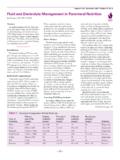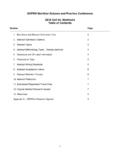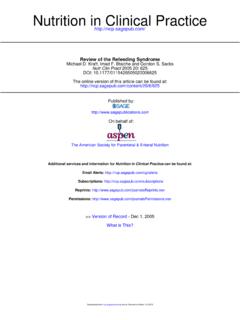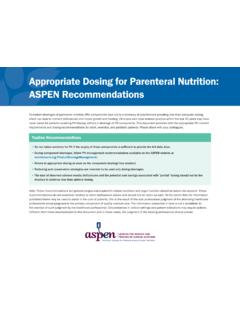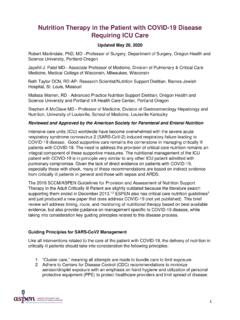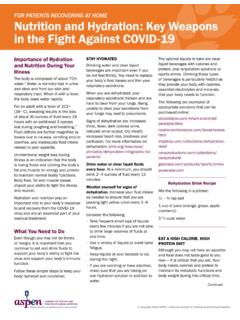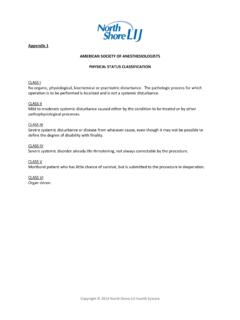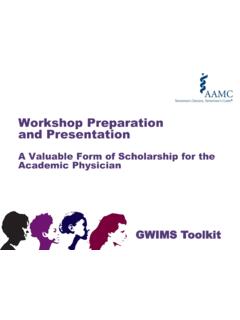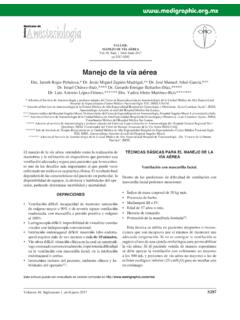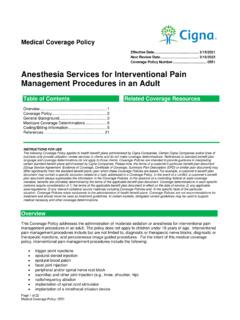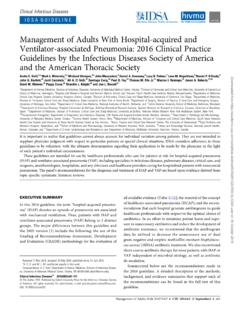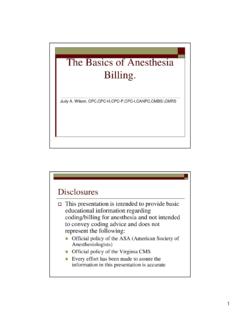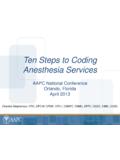Transcription of Journal of Parenteral and Enteral Guidelines for the ...
1 Journal of Parenteral and EnteralNutritionVolume 40 Number 2 February 2016 159 211 2016 American Societyfor Parenteral and Enteral Nutrition and society of Critical Care MedicineDOI: at GuidelinesPreliminary Remarks (Intent of Guidelines ) and SCCM are both nonprofit organizations com-posed of multidisciplinary healthcare professionals. The mis-sion of is to improve patient care by advancing the science and practice of clinical nutrition and metabolism. The mission of SCCM is to secure the highest-quality care for all critically ill and injured LimitationsThese Clinical Guidelines are based on gen-eral conclusions of health professionals who, in developing such Guidelines , have balanced potential benefits to be derived from a particular mode of medical therapy against certain risks inherent with such therapy.
2 However, practice Guidelines are not intended as absolute requirements. The use of these prac-tice Guidelines does not in any way project or guarantee any specific benefit in outcome or judgment of the healthcare professional based on individual circumstances of the patient must always take precedence over the recommendations in these Guidelines offer basic recommendations that are sup-ported by review and analysis of the current literature, other national and international Guidelines , and a blend of expert opinion and clinical practicality. The population of critically ill patients in an intensive care unit (ICU) is not homogeneous. Many of the studies on which the Guidelines are based are lim-ited by sample size, patient heterogeneity, variability in disease severity, lack of baseline nutrition status, and insufficient sta-tistical power for Guideline Review and UpdateThis particular report is an update and expansion of Guidelines published by and SCCM in Governing bodies of both and SCCM have mandated that these guide-lines be updated every 3 5 years.
3 The database of randomized controlled trials (RCTs) that served as the platform for the anal-ysis of the literature was assembled in a joint harmonization process with the Canadian Clinical Guidelines group. Once completed, each group operated separately in its interpretation of the studies and derivation of guideline The current and SCCM Guidelines included in this paper were derived from data obtained via literature searches by the authors through December 31, 2013. Although the commit-tee was aware of landmark studies published after this date, these data were not included in this manuscript. The process by which the literature was evaluated necessitated a common end date for the search review. Adding a last-minute landmark trial would have introduced bias unless a formalized literature search was reconducted for all sections of the Patient Population for GuidelineThe target of these Guidelines is intended to be the adult ( 18 years) critically ill patient expected to require a length of stay (LOS) greater than 2 or 3 days in a medical ICU (MICU) or surgical ICU (SICU).
4 The current Guidelines were expanded to include a number of additional subsets of patients who met the above criteria but were not included in the previous 2009 Guidelines . Specific patient populations addressed by these expanded and updated Guidelines include organ failure (pul-monary, renal, and liver), acute pancreatitis, surgical subsets (trauma, traumatic brain injury [TBI], open abdomen [OA], of Parenteral and Enteral NutritionTaylor et alresearch-article2016 Guidelines for the Provision and Assessment of Nutrition Support Therapy in the Adult Critically Ill Patient: society of Critical Care Medicine (SCCM) and American society for Parenteral and Enteral Nutrition ( )Stephen A. McClave, MD1*; Beth E. Taylor, RD, DCN2*; Robert G.)
5 Martindale, MD, PhD3; Malissa M. Warren, RD4; Debbie R. Johnson, RN, MS5; Carol Braunschweig, RD, PhD6; Mary S. McCarthy, RN, PhD7; Evangelia Davanos, PharmD8; Todd W. Rice, MD, MSc9; Gail A. Cresci, RD, PhD10; Jane M. Gervasio, PharmD11; Gordon S. Sacks, PharmD12; Pamela R. Roberts, MD13; Charlene Compher, RD, PhD14; and the society of Critical Care Medicine and the American society for Parenteral and Enteral Nutrition Keywordsnutrition; critical care; intensive care unit; Enteral ; Parenteral ; evidence-based medicine; Grading of Recommendations, Assessment, Development, and Evaluation criteria; guidelines160 Journal of Parenteral and Enteral Nutrition 40(2)and burns), sepsis, postoperative major surgery, chronic criti-cally ill, and critically ill obese.
6 These Guidelines are directed toward generalized patient populations, but like any other management strategy in the ICU, nutrition therapy should be tailored to the individual AudienceThe intended use of these Guidelines is for all healthcare pro-viders involved in nutrition therapy of the critically ill pri-marily, physicians, nurses, dietitians, and authors compiled clinical questions reflecting key man-agement issues in nutrition therapy. A committee of multidisciplinary experts in clinical nutrition composed of physicians, nurses, pharmacists, and dietitians was jointly con-vened by the 2 societies. Literature searches were then per-formed using keywords (critically ill, critical care, intensive care, nutrition, Enteral , Parenteral , tube feeding, and those related to assigned topics, such as pancreatitis, sepsis, etc) to evaluate the quality of evidence supporting a response to those questions, which were then used to derive a subsequent treat-ment recommendation.
7 The literature search included MEDLINE, PubMed, Cochrane Database of Systemic Reviews, the National Guideline Clearinghouse, and an Internet search using the Google search engine for scholarly articles through an end date of December 31, 2013 (including ePub publications).While preference was given to RCTs, other forms of resource material were used to support the response, including From 1 Department of Medicine, University of Louisville, Louisville, Kentucky; 2 Nutrition Support Specialist, Barnes Jewish Hospital, St Louis, Missouri; 3 Chief Division of General Surgery, Oregon Health and Science University, Portland, Oregon; 4 Critical Care Dietitian, Portland VA Medical Center, Portland, Oregon; 5 Clinical Nurse Specialist: Wound, Skin, Ostomy, UW Health University of Wisconsin Hospital and Clinics, Madison, Wisconsin; 6 Professor, Department of Kinesiology and Nutrition and Division of Epidemiology and Biostatistics, University of Illinois at Chicago, Chicago, Illinois.
8 7 Senior Nurse Scientist, Center for Nursing Science and Clinical Inquiry, Madigan Healthcare System, Tacoma, Washington; 8 Pharmacotherapy Specialist, Nutrition Support, The Brooklyn Hospital Center, Brooklyn, New York; 9 Assistant Professor of Medicine, Division of Allergy, Pulmonary, and Critical Care Medicine, Vanderbilt University School of Medicine, Nashville, Tennessee; 10 Project Research Staff, Digestive Disease Institute, Gastroenterology and Pathobiology, Cleveland, Ohio; 11 Chair and Professor of Pharmacy Practice, Butler University College of Pharmacy and Health Science, Indianapolis, Indiana; 12 Professor and Head, Department of Pharmacy Practice, Harrison School of Pharmacy, Auburn University, Auburn, Alabama; 13 Professor and Vice Chair, Division Chief of Critical Care Medicine, Director of Research John A.
9 Moffitt Endowed Chair, Department of Anesthesiology, Oklahoma City, Oklahoma; and 14 Professor of Nutrition Science, University of Pennsylvania School of Nursing, Philadelphia, of interest disclosures: Dr Taylor disclosed serving as an committee member and Dietitians in Nutrition Support past chair. Dr McClave disclosed other relationships with Nestle (consulting), Abbott (speaker), Metagenics (consulting), Covidien (consultant), and Dr Martindale disclosed other relationships with Davol, LifeCell, and Metagenics (consultant) and received funding from Metagenics (research grant recipient). Dr Warren disclosed serving as cochair for the Veterans Health Administration Dietary Supplement Committee and as a chair for the Dietitians in Nutrition Support Webinar Planning Committee.
10 Dr Johnson disclosed that she does not have any potential conflicts of interest. Dr Braunschweig disclosed serving as the editor for clinical Guidelines . Dr McCarthy disclosed serving as an committee member for the Research Committee and the Abstract Review Committee, an Nursing Section member, and a SCCM Nursing Section member. Dr Davanos disclosed other relationships with Baxter Healthcare (medical science liaison and employee) and NY/LISPEN chapter (president-elect). Dr Rice disclosed other relationships with Avisa, LLC (consultant) and GSK (Data and Safety Monitoring Board) and served as an expert witness. Dr Cresci disclosed other relationships with Metagenics, Advocare, and Covidien; received funding from Metagenics (research grant, speaker); and served as a Research Committee member for and Dietitians in Nutrition Support (chair of the Symposium Planning Committee).
